|
The battle of Stalingrad was fought
between the invading forces of Nazi Germany and the
forces of Soviet Union who were defending the city. The battle was
fought from August
1942 to February of 1943. This was the decisive battle of World
War II because it ended
the German offensive as well as destroying much of the German armies.
Though the early
stages of World War II focused on Western Europe, Hitler had diverted
his attention to
Russia by 1941. At first the huge German war machine focused on
Leningrad and Moscow.
This attack failed and so by the summer of 1942 Hitler wanted to invade
southern Russia.
Against the advice of his generals Hitler attacked Stalingrad. The
German forces took much
of the city. German armies surrounded the city and so the Russians
were trapped and would
remain so for several months. When reinforcements arrived for the
Soviets they surrounded
the Germans and forced them to surrender. The battle of Stalingrad
not only destroyed much
of the German army, but also ended their offensive in Russia and
ultimately resulted in
Germany’s defeat in the second World War.
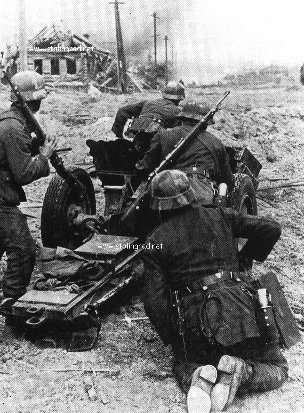
World War II began after years of German dominance in central
Europe. Germany had
annexed many nearby nations before war was finally declared in September
1939. Nazi
Germany had many early successes because their military had been
mobilized for a long
time while the allies, who at this point were only Britain and France,
were less prepared,
especially the French. Hitler wisely signed a non-aggression pact
with Stalin and by doing
so Germany easily overwhelmed Poland and other lands in Eastern Europe
by the end of
1939. By this point the allies were entrenched in France expecting
a repeat
of World War I. In the spring of 1940, the Nazi blitzkrieg
continued as they occupied
Denmark, Norway, and Holland. Now, Germany turned toward France
and surprised the
allies by invading through Belgium. Within several weeks France
was occupied and the
British had been driven off the continent. By July 1940, Germany
dominated nearly all of
continental Europe, as Italy was an ally and Russia was neutral.
Germany saw Britain as
its last remaining enemy and so prepared for an invasion. In order
to do so Hitler
recognized that air supremacy would be necessary for any successful
invasion to take place.
The German air force, the Luftwaffe, was met with great resistance, and
by late 1940 Hitler
gave up hope of an immediate invasion of Britain. At this point,
the best strategy for
Germany would have been to attack North Africa and the Middle East as
this would give
Germany the Suez Canal and therefore would cut off Britain’s supply of
oil. Instead Hitler’s
obsession with a vast eastern European empire had already determined
that his next course
of action would be to invade the Soviet Union.
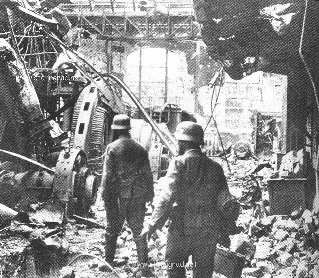
With western Europe secure, for the time being, Hitler decided to
embark on a massive
campaign through the Soviet Union. This was known as Operation
Barbarossa. It would
eventually be the greatest land battle in history, with over 25 million
casualties from its
beginning in June 1941 to its end in July 1943 when the Soviets began a
counter offensive that
would eventually lead to Germany’s defeat in 1945. Operation
Barbarossa was flawed
from the start. First, it didn’t start until the summer of 1941
as Hitler had been occupied in
the Balkans during the spring. Hitler didn’t think much of the
lateness of the beginning of
his invasion because he anticipated a quick victory before the Russian
winter that had
stopped Napoleon set in. Hitler also greatly underestimated the
power of the Red Army.
In the beginning, both sides had over 3 million men each but while
the Germans had only
3300 tanks, the Soviets had 20,000 which gave them a distinct advantage
even though many
of their tanks were obsolete. Another problem for Germany was
Hitler’s lack of tactical
knowledge. This was shown when he at first pushed towards Moscow
then split up his forces to attack Leningrad to the north and the
Caucasus as well as Moscow.
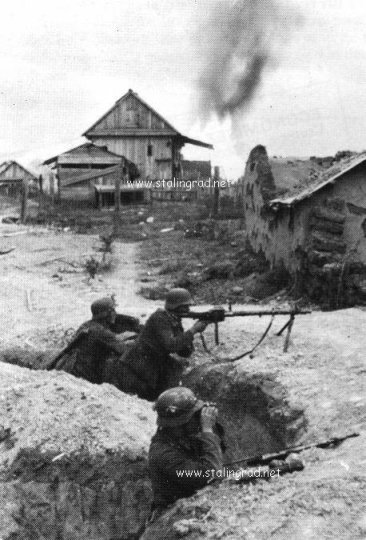
These factors would make it seem as though operation Barbarossa was
doomed from the
start, but this was not so. The Luftwaffe played key roles
including the destruction of the
Soviet air force. The Luftwaffe destroyed the largest air force in
the world in only two days.
General Rychagov, the Commander of Russian Aviation, was sentenced to
death for what
Stalin called “treasonable activity” (defeat in battle).
Despite Hitler’s tactical incompetence,
his armies quickly advanced thanks to the tactics that the german
generals employed. The
German army was very mobile and so could easily surround and overwhelm
Russian armies
that usually surrendered soon afterwards. German tactics led to
staggering defeats for the
Russians who often lost ten lives compared with only one German life.
In August of 1941
one of Hitler’s generals, Guderian contacted him. Guderian
requested that an attack be
made on Moscow but Hitler said to stick with the current strategy.
Hitler was angry, but
admitted to Guderian, “had I known Russian tank strength... I would
not have started this
war.”. Despite Hitler’s concerns the Germans were still successful
having captured Minsk,
Smolensk, and Kiev. Finally, in October, Hitler agreed to attack
Moscow. In late November
the attack on Moscow, known as operation Typhoon, began. The
attack failed and at the
end of 1941 Hitler wondered what could be holding Russia together.
The Russians had lost
3 million men and half of its economic base. Russia still had 9
million men that were of
military age and had produced 4,500 new tanks over the winter, and so a
continued war favored
Russia since at this point Germany could not match those numbers.
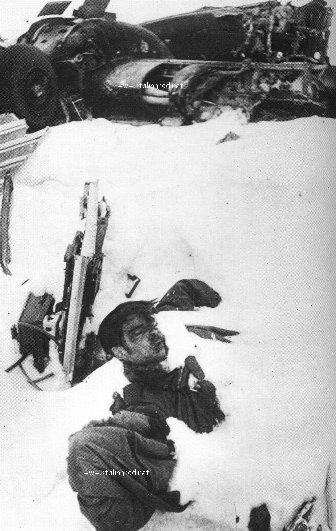
In May of 1942, Hitler began operation BLUE whose objective was to
capture southern oil
fields. Later in May Stalin began to allow his troops to retreat
which overrided his famous
earlier order, “Not one step back!” Also by this point the
Russian soldiers heard of the horrible
POW camps and now preferred to die in battle than be captured.
Both of these factors reduced
the number of Russian soldiers that were captured during the war.
In July the German 6th Army,
led by Paulus, advanced toward Stalingrad. At the same time
Russian General Chuikov also
moved toward Stalingrad to help General Zhukov who was in charge of the
defenses of Stalingrad.
Despite the German army’s huge losses Hitler was determined to take
Stalingrad. Stalin did
not want to let it fall especially because it was named after himself.
Hitler wanted the city not
only because it dominated the Caucasus and its oil fields, but also for
its symbolic and
propaganda value. He also believed that if he took Stalingrad it
would eventually lead to the
destruction of the Soviet Union.
The battle of Stalingrad began on August 23, 1942 at 6:00 P.M. when one
thousand German
planes dropped incendiary bombs on the city. Air raids such as
these were very destructive
especially since many buildings were made out of wood. One raid of
600 planes killed an
estimated 40,000 civilians. That same day the German army arrived
in the suburbs of Stalingrad.
The first attacks by the German panzers were taken by a single division
of troops and some
workers from a nearby factory. When the German soldiers entered
the city they found the ruins
from their bombings. They were surprised to find any life left in
the city. Many small battles
erupted soon afterwards. The German army encountered fierce
resistance from not only the
determined soldiers of the Red Army, but also from the patriotic
civilians as well. Hitler had
already claimed victory just as Napoleon had in 1812, but this battle
was far from over.
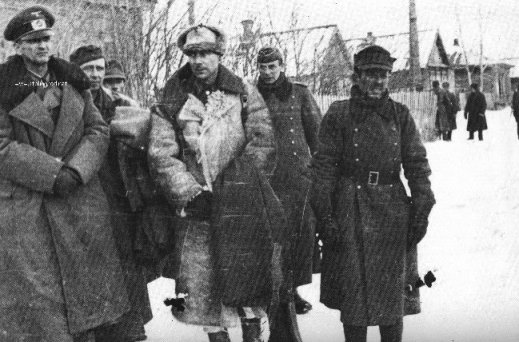
Fighting
was harsh and neither side made many gains. One German general
said, “The mile, as a
measure of distance, was replaced by the yard...”. Even with the
great efforts of the Soviet
forces they were losing ground. The fighting was still severe even
though the Russians were
out numbered. A hill known as Mamaev’s Mound changed sides at
least eight times during the
battle. Battles were even fought in the sewers. One house
was defended by a single platoon
of troops under the command of Russian sergeant Pavlov. That house
became known as
Pavlov’s house because they were surrounded, but still held out
against the Germans for 59
days until they were reinforced. Pavlov would even survive the
war. There were many
cases of fanatical efforts by troops of both sides. A Soviet
artilleryman Aleksei Petrov was
in his first battle when he was looking from a comrade to return from
patrol but he was lying
dead on the streets. Petrov began to scream and run at a nearby
house where a few Germans
tried to surrender but Petrov killed them with his submachine gun.
He heard another German
begging in the hallway,”On God, let me live.”Petrov shot him in the
face and went to the
second floor where he killed three more Germans. He then silently
left the house and returned
to his post. One German soldier and twelve of his troops charged a
building and took 80
prisoners, an anti tank gun and left dozens of Russians dead. In a
factory in the city the Russians
had set up a sniper school headed by Vasily Zaitsev. Zaitsev had
killed 40 Germans in ten days.
He become famous among both sides and a German sniper, Colonel Heinz
Thorwald was
flown in to fight him. The two snipers searched for each other
until finally Zaitsev found a
place where his comrades had been mysteriously shot. Zaitsev’s
friend looked out for a split
second and was shot. He now knew where his enemy was.
Thorwald thought he had just
killed the Russian sniper and looked out. That was when Zaitsev
hit him. In the whole battle
of Stalingrad Vasily Zaitsev was credited with killing 242 Germans.
Then he was blinded by
a land mine. Many of the tense battles were fought near the
Central Train Station were
Soviet guardsmen barricaded the train cars against German attackers.
The German Luftwaffe
was making thousands of attacks a day and their artillery bombarded the
city so to neutralize
this, General Chuikov ordered his forces to remain very close to the
German troops so that
German airstrikes would endanger their own forces. The city was
surrounded by German
forces. For Russian reinforcements to arrive they would have to
cross the Volga river while
under German fire. Witnesses said that on some days the river
would turn red with the blood
of the dead soldiers. Fighting was continual and never stopped.
Sometimes it might slow
down, but minutes later it would start again with new energy.
General Chuikov described one
German attack, “That morning you could not hear the separate shots or
explosions: the whole
merged into one continuous deafening roar.”.
The overpowered Soviets had been driven back and Germany occupied
80% of the city.
Because often the two sides would be very close to each other, hand to
hand fighting was
very common. Many battles were fought with knives and bayonets.
Bodies piled up in the
streets and the city became a hellhole as one German lieutenant said,
“Stalingrad is no longer
a town. By day it is an enormous cloud of burning, blinding smoke;
it is a vast furnace lit by
the reflection of the flames...Animals flee this hell; the hardest
stones cannot bear it for long;
only men endure.”. The battles were dominated by infantry
because tanks had a difficult
time maneuvering through the ruins. The deployment of tanks in the
city was a serious
error as they were virtually useless and they would not be
available as a reserve force in
case of a Soviet counterattack. After a few months of fighting,
several events put pressure
on Germany in Africa. On November 5th 1942 the German General
Rommel had been
defeated at El Alamein in Egypt, and on the 8th the Allies had landed in
Morocco and
Algeria which threatened the Axis on a new front. These two events
coincided with General
Zhukov’s plan to unleash a reserve force. Secretly being built
up was a force of a million men,
14,000 heavy guns, 1,000 tanks, and 1,350 aircraft. The flanks of
the German force were
guarded by inferior allied divisions. These forces were weaker and
they didn’t have anti-tank
defenses or armored units. The Russians planned to exploit this
weakness in an offensive
known as Operation Uranus. The Soviets did an excellent job of
concealing their plans and
the Axis forces were caught totally off guard. Only Romanian units
suspected anything but the
German command ignored them. On November 19th 1942 a massive
Russian attack surprised
and overran the Romanian Third army which exposed the left flank of the
German Sixth Army.
A day later another attack destroyed a mixed force composed of Germans
and Romanians,
that protected the right flank of the German Sixth Army. Four days
later Russian assault
groups joined up and now General Paulus and his army, the same one that
had taken Paris in
1940, was cut off from supply lines. 280,000 German troops had
been surrounded by the
Russians in only a few days. The German Army High Command begged
Hitler to allow
Paulus to retreat while he still could. The Luftwaffe Chief Herman
Goering claimed that he
could fly in 500 tons of supplies a day to the surrounded Sixth Army,
which would be enough
to keep it going. Hitler agreed to this and on November 22nd 1942
he ordered Paulus to
fortify his position and wait for reinforcements to arrive.
General Manstein arrived with
reinforcements and told Paulus to join up with him. Paulus refused
because he didn’t have
a direct order from Hitler to do so. Manstein’s force was driven
off and now Paulus and
his army were alone, surrounded, and at the mercy of the Russians and
the cold winter.
Since Hitler had believed that this offensive would not take too long,
and since it was started
in the summer the soldiers were not provided with winter clothes.
They were running low
on supplies thanks to the lack of supplies being delivered by the
Luftwaffe. The Luftwaffe
could only fly in about 100 tons a day while they needed over 500.
Only one day did the
airlift provide enough supplies. The planes brought wounded
soldiers home and they also
brought mail from the soldiers bidding farewell to the people they knew
in Germany because
they knew they would die. When General Paulus saw the miserable
conditions his soldiers
were in, he sent someone to plead with Hitler. In response Hitler
told him to hold out and
that reinforcements would arrive. Conditions were miserable.
Temperatures dropped to
negative 30 degrees Celsius. Because of the lack of supplies the
daily ration for soldiers
was dropped from an already low 100 grams of bread a day, to 50 grams a
day. One German
soldier described the misery that they faced, “Only the toe of
jackboot or an arm frozen to
stone could remind you that what was now an elongated white hummock had
quite recently
been a human being.”. German soldiers had to slaughter their
horses for food and then later
they had to dig up the horses bones to eat. On January 8th 1943
the Russians demanded that
the Germans surrender, but they refused and two days later the Russians
attacked. Paulus
radioed to Hitler that it was hopeless, but Hitler insisted that Paulus
would not surrender.
By the 25th of January 1943, the Russians took the last German airfield
thus totally cutting
off the flow of supplies. By this point the German army was almost
out of food and ammunition.
Thousands of soldiers were wounded but couldn’t be helped because
there were no medical supplies.
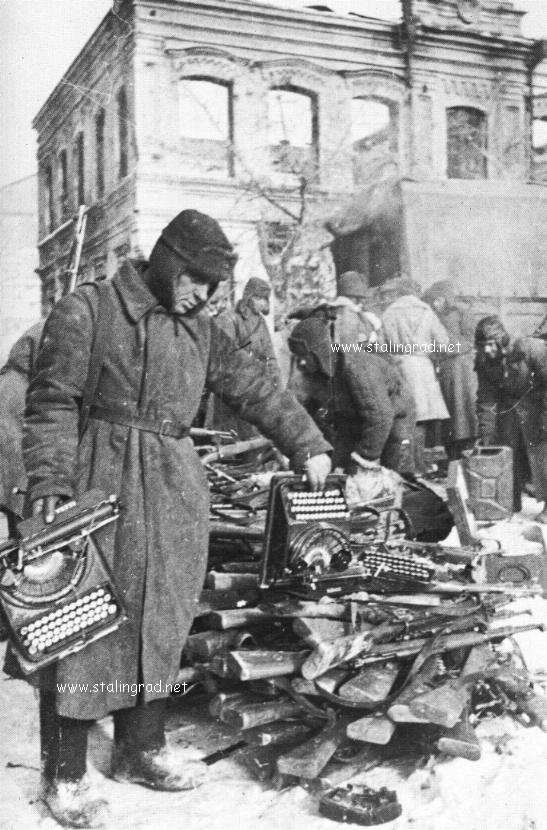
On January 31st, 1943 Hitler promoted Paulus to field marshal and
reminded Paulus that never in
Germany’ s history had a field marshal surrendered. Hitler urged
Paulus to commit suicide to
avoid the dishonor of having to surrender from happening, but instead
Paulus finally surrendered
on February 2nd, 1943. The Russians took over 110,000 prisoners
including 24 generals.
In the whole battle of Stalingrad over 400,000 German soldiers died.
The defeat at Stalingrad
went further than casualties and captured soldiers, but it also ended
the German campaign in
Russia. It also showed that the Germans could be beaten at their
own game. The battle of
Stalingrad was the first major victory for the Soviets and set the stage
for a counter offensive
that would not only reclaim all of their lost land, but would eventually
bring them to Berlin.
When Hitler heard of Paulus’ surrender he said,” The God of war has
gone over to the other side.”.
Less than a week after the battle of Stalingrad was over, Soviet forces
reached the Sea of Azov
which cut off one of the three German armies deployed in Russia.
In March the Russian Army
began to push westwards. In response the Germans began to amass
Panzer units behind the front
lines. German command debated about how to proceed. General
Manstein suggested that the
Soviets be allowed to advance greatly and then the Germans would cut
them off and surround them.
Hitler refused to follow this plan on the basis that it was politically
risky because it gave ground
to the Soviets. Instead Hitler decided to gather nearly all of his
tank forces for an attack at the
Kursk salient( a bulge in the front lines). Hitler wanted to
attack Kursk because it was a
crossroads for many railroads. Again, Hitler ignored the advice of
General Manstein by
delaying the attack until the new Panther and Tiger tanks were ready.
This delay in the attack
gave the Soviets time to prepare for the battle. Hitler wanted to
wait for the new tanks because
he wanted to do everything possible to ensure victory. He hoped
that a victory at Kursk would
demonstrate that even after the decisive defeat at Stalingrad the German
armies were still the
most powerful in the world. Hitler was so obsessed with winning at
Kursk that for the battle he
drew on reserves from as far away as France. When Soviet
Intelligence confirmed the German
plans for Kursk General Zhukov began preparations for a huge defense.
There were three
defense lines, each of which had its own line of reserves. These
troops were protected by
400,000 land mines and many anti-tank guns. By July 4, 1943 both
sides had put over
2 million troops, 6,000 tanks, 5,000 planes, and 30,000 heavy guns into
an area of less than
9,000 square miles. The defending Soviet forces had 1.3 million
troops, 3,000 planes, 3,400
tanks, and 20,000 heavy guns, while the Germans only had 900,000 troops,
2,000 planes,
2,700 tanks, and 10,000 heavy guns. Fighting began on July 5th,
1943. Since there were
so many troops in such a small space the fighting was very intense as
Guy Sajer, a German
soldier said: “Daylight turned to darkness and was interrupted
by brilliant flashes of nearby
explosions. The earth trembled and bushes and trees exploded into
flame by spontaneous
combustion from the intense heat. The German troops were frozen
with fear, unable to move
or even scream at times and at other times driven to howling like
animals while desperately
trying to bury themselves deeper to escape the terror, while
clutching one another like children.
Those who peered out were thrown back into the shelter in
pieces.”. The new Tiger tank as
well as the assault guns called Ferdinands dominated the battle.
The Tiger had an 88mm gun
with a thousand yard range. The Ferdinand guns were even more
powerful and could outrange
any Soviet guns. The Germans planned to use the Tigers and the
Ferdinands to weaken the
Soviet defenses to allow infantry and light tanks to advance.
Unfortunately for the
Germans this was not enough, and so the Germans were forced to engage in
battle.
The new German tanks were so much better that it was very common for the
fanatical
drivers of the Russian T-34 tanks to intentionally crash into the German
tanks so as to destroy them.
The fighting reached its peak on July 12th, 1943 when both forces were
very close to each other.
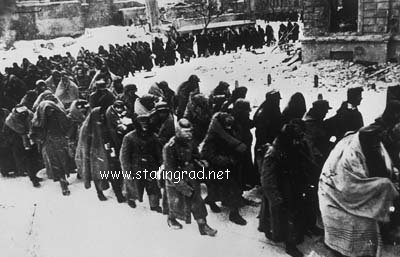
The air forces and artillery guns stopped firing so that they wouldn’t
hit their own men.
Hundreds of tanks were lost that day and Hitler realized that defeat was
inevitable so on
July 13th, 1943 he ordered a withdrawal. This was not only because
of the situation at Kursk
but also because the Soviets were advancing elsewhere. Also at the
same time the British and
Americans had just landed in Sicily. The battle of Kursk was the
biggest tank battle in history.
The defeat there, in addition to the defeat at Stalingrad, crippled the
German military. This as
well as the fact that Soviet production overtook German production led
to the success of the
Russian counter offensive which led to Allied victory in World War II.
The Soviet victory at Stalingrad and as a result their successful
defense against the German
Operation Barbarossa was definitely the decisive factor in the outcome
of World War II.
Because the battle of Stalingrad gave the Soviets the initiative, the
Red Army regained Russia’s
lost land and afterwards invaded Germany’s land in a relatively short
time. Russia gained more
than just its former territory, but also it gave the Soviet Union
control of virtually every Eastern
European country with the notable exception of Greece. The victory
at Stalingrad was celebrated
with the construction of a statue of Mother Russia. The 52 meter
statue was built to remember
the more than one million Soviet troops that died defending the city.
The great success of the
Russian counter offensive gave the rest of the world fear of the Soviet
Union and its leader
Stalin. This was due to the fact that Soviet forces had fought
against impossible odds and
had won in the end. Stalin and the Soviets faced Hitler more
boldly than the Western allies
had. This was shown by how the Soviets sacrificed nearly
everything in the war while
Britain and the United States were very hesitant about opening up a
second front which happened
nearly two years after Germany invaded Russia when the allies
invaded Italy. The delaying in
opening up the second front in Europe led Stalin to believe that his
Western allies wanted
Russia to win, but that they wanted the victory to be as costly for the
Soviets as possible.
When the leaders of the Soviet Union, the United States, and Great
Britain-Stalin, Roosevelt
and Churchill met in Yalta in February of 1945 there was a great deal of
rivalry and resentment
between the western allies. Stalin refused to give up any of the
territory that the Soviet Union
had conquered from Germany. The three allies did agree on how
Germany was to be split up.
The Soviet Union would receive the eastern half while Britain, France,
and the U.S. would split
up the west. The allies agreed to have a trial for Nazi war
criminals as well as determining what
reparation Germany owed and to what countries. The meeting at
Yalta was the last meeting
between the leaders of the three major allies and its outcome was the
Cold war which lasted
for over 40 years. During this time the former allies were split
and instead of in World War II
where fascism was seen as the common enemy, capitalism and communism
became enemies.
The battle of Stalingrad was fought from August 1942 to February of
1943. Over two million
soldiers died in this battle, most of whom were Soviets. The
battle ended the German invasion
of the Soviet Union. This began the Soviet counter offensive which
would eventually capture
Berlin in 1945. The early part of World War II focused on Western
Europe, but by 1941 Hitler
was ready to invade the Soviet Union. Though the blitzkrieg tactic
worked at first, it failed when
the Germans attacked Stalingrad. Here the German army had to enter
the city and fight a long
and vicious battle with the Soviets. The intense cold, stubborn
Soviet resistance and eventually
the lack of supplies all contributed to the eventual defeat of the
German army. The Soviets
responded with their own offensive which eventually led to Germany’s
defeat in World War II.
The Soviets won by using the same tactic that the Germans had
successfully used against them:
they attacked the flanks and surrounded them. The victory at
Stalingrad proved to be the end
of Nazi Germany’s peak and the beginning of its rapid decline until
its final destruction in 1945.
Hitler and his short lived empire collapsed as a result of the battle of
Stalingrad because it
destroyed much of the German forces and also ended the offensive in
Russia. This eventually
turned the tide and led to not only the destruction of Germany but also
ushered in a new era of
global politics and never again would a war of such magnitude ever be
forced upon the world.
Thanks Arno ! |